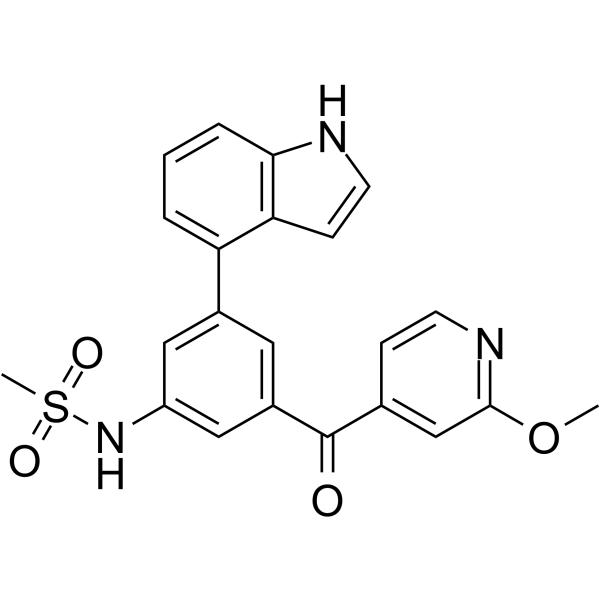
LP-261
CAS No. 915412-67-8
LP-261( —— )
Catalog No. M28789 CAS No. 915412-67-8
LP-261 is a novel tubulin targeting anticancer agent that binds at the colchicine site on tubulin, inducing G2/M arrest.
Purity : >98% (HPLC)
 COA
COA
 Datasheet
Datasheet
 HNMR
HNMR
 HPLC
HPLC
 MSDS
MSDS
 Handing Instructions
Handing Instructions
| Size | Price / USD | Stock | Quantity |
| 2MG | 41 | Get Quote |


|
| 5MG | 65 | Get Quote |


|
| 10MG | 110 | Get Quote |


|
| 25MG | 177 | Get Quote |


|
| 50MG | 335 | Get Quote |


|
| 100MG | 500 | Get Quote |


|
| 200MG | Get Quote | Get Quote |


|
| 500MG | Get Quote | Get Quote |


|
| 1G | Get Quote | Get Quote |


|
Biological Information
-
Product NameLP-261
-
NoteResearch use only, not for human use.
-
Brief DescriptionLP-261 is a novel tubulin targeting anticancer agent that binds at the colchicine site on tubulin, inducing G2/M arrest.
-
DescriptionLP-261 is a novel tubulin targeting anticancer agent that binds at the colchicine site on tubulin, inducing G2/M arrest.(In Vitro):LP-261 was tested as a single agent in colon adenocarcinoma (SW620) and prostate cancer (LNCaP and PC3) xenografts, evaluating several different dosing schedules. LP-261 was also used in combination with bevacizumab in the SW620 xenograft model. LP-261 also exhibited high oral bioavailability and apparent lack of efflux by intestinal transporters such as ABCB1. LP-261 is a very potent inhibitor of angiogenesis, preventing microvessel outgrowth in the rat aortic ring assay and HUVEC cell proliferation at nanomolar concentrations. Complete inhibition of tumor growth was achieved in the PC3 xenograft model and shown to be schedule dependent. Excellent inhibition of tumor growth in the SW620 model was observed, comparable with paclitaxel.(In Vivo):LP-261 significantly inhibits growth of a human non-small-cell lung tumor (NCI-H522) in a mouse xenograft model.
-
In VitroLP-261 shows potent G2/M block activity in multiple cell lines and exhibits a range of activity from 0.01μM to 0.38 μM across the tested cell lines, the IC50 values for MCF-7, H522, Jurkat, SW-620, BXPC-3, and PC-3 values are 0.01 μM, 0.01 μM, 0.02 μM, 0.05 μM, 0.05μM and 0.07 μM, respectively.LP-261 exhibits low micromolar potency in the tubulin polymerization assay, the EC50 value of LP-261 is 5.0 μM. LP-261 has the ability to compete with colchicine for binding to tubulin in a[3H]colchicine competition binding assay, the EC50 (3.2 μM) for LP-261 to inhibit the binding with a potency similar to that of colchicine itself, and it exhibits a 79% inhibition at a conctration of 30 μM.
-
In VivoLP-261 (oral gavage; 4 mg/kg; single dose) displays rapid adsorption by the oral route (Tmax=2.0 h), the terminal half-life of 1.4 h ( 0.2 h indicated a moderate rate of elimination in rat, and the volume of distribution (Vss) is 1.25 L/kg.LP-261 (oral gavage; 15 or 50 mg/kg; twice daily; 28 days) at 50mg/kg results in an approximately tumor volume of 130 mm3 versus 3769 mm3 in the vehicle treated group, this represents a 96% reduction in mean tumor volume. Meanwhile, LP-261 at 15 mg/kg leads to a 41% inhibition after 28 days in this mouse model. Animal Model:Human tumor xenograft model (Injected with NCI-H522 human non-small-cell) in NCr-nu mice Dosage:15 or 50 mg/kg Administration:Oral gavage; 15 or 50 mg/kg; twice daily; 28 days Result:Had potent anti-tumor efficacy at high dosage and exhibited no significant changes in body weights.
-
Synonyms——
-
PathwayCytoskeleton/Cell Adhesion Molecules
-
TargetMicrotubule/Tubulin
-
RecptorNrf2|p38|ERK|influenza virus
-
Research Area——
-
Indication——
Chemical Information
-
CAS Number915412-67-8
-
Formula Weight840.92
-
Molecular FormulaC44H36N6O8S2
-
Purity>98% (HPLC)
-
SolubilityIn Vitro:?DMSO : 33.33 mg/mL (79.08 mM)
-
SMILESCOc1nccc(C(c2cc(NS(C)(=O)=O)cc(-c3c(cc[nH]4)c4ccc3)c2)=O)c1COc1nccc(C(c2cc(NS(C)(=O)=O)cc(-c3c(cc[nH]4)c4ccc3)c2)=O)c1
-
Chemical Name——
Shipping & Storage Information
-
Storage(-20℃)
-
ShippingWith Ice Pack
-
Stability≥ 2 years
Reference
1.Ma LL, et al. Rupestonic acid derivative YZH-106 suppresses influenza virus replication by activation of heme oxygenase-1-mediated interferon response. Free Radic Biol Med. 2016 Jul;96:347-61.
molnova catalog



related products
-
Oxymatrine
Oxymatrine is an alkaloid isolated from Sophora flavescens, used as the antibiotic. It is a traditional Chinese medicine used in the treatment against hepatitis B virus.
-
Rauwolscine hydrochl...
Rauwolscine, a natural alkaloid, is a specific and reversible α2-adrenergic receptor antagonist (Ki: 12 nM).
-
BNC105
BNC105 is a tubulin polymerization inhibitor. It has potent antiproliferative and tumor vascular disrupting properties.



 Cart
Cart
 sales@molnova.com
sales@molnova.com


